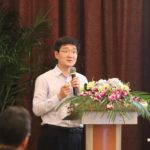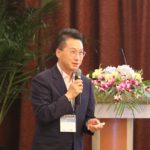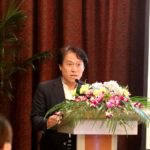As part of the 3rd YSLME Science Conference, the Parallel Event 4 on Nutrient Management in YSLME was conducted from July 18-19, 2019. The event looked into several studies conducted in PR China and RO Korea regarding the status of nutrient inputs from selected river basins, atmosphere-based and sea-based sources, as well as progress made in nutrient reduction in the Yellow Sea. Based on the information and data available, the session also discussed possible opportunities to further strengthen policy developments and regional cooperation in improving nutrient reduction.
On behalf of PR China, the session was opened by Mr. Ziwei Yao, NMEMC, PR China, who shared a short background about NMEMC, particularly its roles in monitoring the Bohai Sea, developing technical standards for marine environment and publication of annual reports on marine environmental quality. NMEMC has been supportive of the YSLME initiative related to nutrient reduction since its first phase. Mr. Yao hoped that this event would contribute to better understanding root causes and distribution of nutrients, as well as find ways to better manage reduction of nutrient load in the Yellow Sea region.
On behalf of RO Korea, Mr. Chang Hee Lee from Myongji University, RO Korea, delivered the opening address. Mr. Lee indicated that Yellow Sea is one of the most exploited seas in the world, and has often experienced harmful algal blooms: red tide, green tide and golden tide. Furthermore, increasing population also contributed significantly to increase nutrient enrichment in coastal areas. As such, nutrient control practices need to be put in place. Under the YSLME project and with the YSLME Strategic Action Program’s (SAP) target to reduce nutrient loading from land-, ocean-, and atmosphere-based sources, there are good opportunities for regional cooperation in this aspect.
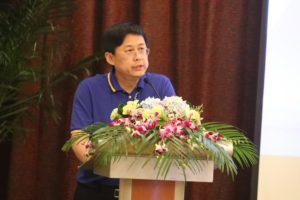
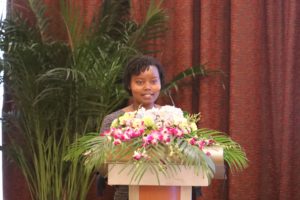
Keynote Address
Setting the tone of discussions were two keynote presentations, with Mr. Joong Ki Choi moderating the session.
Ms. Milcah Ndegwa, Associate Programme Management Officer, UNEP, Nairobi, Kenya, delivered the first keynote on GPA/Global Partnership on Nutrient Management (GPNM), progress and prospects. According to Ms. Ndegwa, the accelerated use of nitrogen and phosphorus is becoming one of the key issue areas that provide both development benefits and environmental problems. There are two major projects on nutrients management: (1) the Global foundations for reducing nutrient enrichment and oxygen depletion from land-based pollution in support of Global Nutrient Cycle (GNC) which was implemented from 2012 to 2019; and (2) the ongoing International Nitrogen Management (INMS) project. Under the GNC project, a GPNM policy toolbox was developed and related trainings were conducted. Ecosystem health development report cards were also published (i.e., Chilika Lake; Laguna de Bay). These initiatives are contributing to achieving UN SDG 14.1 which aims to significantly reduce marine pollution of all kinds, in particular from land-based activities by 2025. In March 2019, the United Nations 4thAssembly (UNEA4) adopted the Sustainable Nitrogen Management Resolution which called for improved coordination of policies across the global nitrogen cycle at the national, regional and global levels; improved management of the global nitrogen cycle, through the sharing of assessment methodologies, best practices and emerging technologies for recovery and recycling of nitrogen; coordinated management of information to facilitate decision-making particularly around the quantification of health; and economic benefits and contributing to capacity building. The INMS Project will implement a substantial part of this resolution by developing evidence based effective practices for global nitrogen management.
In line with Ms. Ndegwa’s keynote, Dr. Ning Liu of NOWPAP shared a brief information on the NOWPAP Eutrophication Assessment Tool (NEAT) which uses asatellite imagery technique for timely detection of potential dead zones in the sea.
The second keynote was delivered by Dr. Chang Hee Lee, President of the Korean Society of Water Environment and Head of the Department of Environmental Engineering and Energy, Myongji University, RO Korea. His presentation focused on mitigation of chemical oxygen demand (COD) and total phosphorus (TP) by implementing Total Pollutant Load Management System (TPLMS) in the Shiwa coastal reservoir (SCR). The first-phase TPLMS action plan was implemented in 2013 to accomplish the interim water quality targets by 2018. Maximum daily loads were allocated to four municipalities within the SCR watershed. The load reduction measures included traditional point source measures as well as diverse nonpoint source control measures (i.e., construction of nonpoint source (NPS) treatment facilities, road sweeping, wetland improvement, and dredging contaminated sediments). While these measures were implemented timely and considered successful, the scheduled development projects experienced some delays because of recent economic setback. The 2ndphase of TPLMS is seen to be more challenging due to additional water quality targets that were set in the inner area where tidal mixing is limited, and load reduction measures for NPS are also seen as inefficient due to high cost and low reduction amount.
During the discussion, Mr. Lee further underscored the need to establish a national coordination mechanism which will involve coordination with relevant ministries on nutrient management, to effectively implement the plan that was developed by the Ministry of Oceans and Fisheries (MOF) of RO Korea. He further emphasized that putting up treatment facilities require tremendous investment, currently two facilities have been established, but none yet for NPS.
As for NOWPAP, Dr. Liu indicated that most of their efforts are focusing on scientific research and through the help of partner governments, they hope to bridge the gap between science and policies.
Ms. Ndegwa further clarified that UNEP was given the mandate to implement the UNEA4 resolution, and as such linkages will be made in the GNC and INMS projects, but INMS project will be on a larger scale.
Session 1
The first session focused on status of nutrients inputs from land-, atmosphere- and sea-based sources. The session was moderated by Mr. Ziwei Yao.
Mr. Lijun Wang, from the National Marine Environmental Monitoring Center (NMEMC), Ministry of Ecology and Environment, PR China, shared the study on land-based nutrient loadings in Haizhou Bay, Jiangsu Province.For the nutrient production and discharge estimation, a series of data was collected, including the information of the river network, the data of DEM, land use, river water flow, amount and type of livestock farming, urban and rural population, industry wastewater discharge, fertilizer use, etc. ArcGIS software was employed for export coefficient model building. The result showed that Linhong River is the major nutrient pollutant source to Haizhou Bay. Mr. Wang underscored that while the contribution of pollution sources showed an almost equal/ identical TN and TP loading, the potential loading from fertilizer use should not be ignored, especially in the wet year or flood season, when nutrient loading may dramatically increase.
Mr. Hong Lae Cho, CEO of HydroCore Ltd, RO Korea, shared their study on watershed modeling and nutrient loadings in Han River, RO Korea. Mr. Cho emphasized the importance of understanding the spatio-temporal distributions of pollution loads in order to effectively reduce pollution loads in the Yellow Sea. Focusing on Han River watershed which accounts for 34.3 percent of total area of RO Korea.
To effectively decrease the pollution loads to the YS, it is critical to understand the spatio-temporal distributions of pollution loads. In RO Korea, there are four major river systems that flow to the YS: the Han, Geum, Mankyoung-Dongjin, and Youngsan rivers. The pollution loads from each of these river systems need to be evaluated using the best available science-based methodology. Using REDPOLL as watershed model in Han River, flows and pollution loads to the YS were evaluated for the year 2016 based on simulation results. River flows and pollution loads have a very wide range of daily and monthly variation. As affected by the monsoon weather system, the monthly volume of river flows in July reaches 7,484 x 106 m3/month accounting for 35.2% of the annual discharge. Likewise, the monthly pollution loads in July comprise more than a quarter of the annual loads: SS 49.4%, BOD 40.0%, TN 30.9% and TP 41.6%. In the Han River Watershed, the majority of pollution loads come from the diffuse sources: SS 99.8%, BOD 86.8%, TN 75.2%, and TP 92.7%.
Dr. Yoonseok Choi, Korea Laboratory Accreditation Scheme Assessor, National Institute of Fisheries Science in West Sea Fisheries Research Institute (WSFRI), RO Korea, introduced the results of investigations on temporal and spatial variations conducted in the west coastal areas of Yellow Sea covering years 1974 to 2014. Water samples were collected at 60 stations and physicochemical parameters were analyzed including water temperature, salinity, SS, DO, Chlorophyll a and nutrients. Medium-term trends and distribution patterns of water quality were investigated. Spatial distribution patterns of temperature, pH and DO were not clear among stations but the seasonal variations were distinct except ammonium. The results of water quality evaluation index (WQI) values is 25, and ecology-based seawater water quality criteria were grade Ⅱ (Good).
Dr. Tae Wook Kim, Assistant Professor, Korea University, RO Korea, presented on atmospheric deposition of inorganic nitrogen to East Asian marginal seas. Dr. Kim emphasized that the atmospheric deposition of anthropogenic nitrogen is an increasingly important new source of nitrogen to the ocean. His presentation showed the concentrations and depositional fluxes of nitrate and ammonium in airborne total suspended particles and precipitation, and factors affecting them based on three-year observation data collected in Uljin, eastern coastal site of RO Korea, which is adjacent to the East Sea. Their study found that atmospheric nitrogen deposition could contribute to approximately two percent of phytoplankton production in the southwestern East Sea. Furthermore, nitrogen and oxygen isotopic ratios in atmospheric and seawater samples also have significant contribution of atmospheric nitrogen deposition to the nitrogen pool in the East Sea. This atmospheric deposition also directly reduces ocean alkalinity. Similar investigations are also being conducted in Songdo, western coastal site of RO Korea and to an ocean site in Yellow Sea.
Ms. Limin Yu, Senior Engineer, NMEMC, Ministry of Ecology and Environment, PR China, shared the results of their monitoring of the dry and wet atmospheric deposition of nitrogen and phosphorus over the west coast of Yellow Sea. Their study showed that the size distribution of ammonium exhibited bi-modal in the dust season and uni-modal in the other seasons, while the remaining nitrogen components exhibited bimodal/multimodal size distribution, and multimodal distribution for phosphorus in atmospheric aerosols. The deposition velocities of the particulate nitrogen were calculated with the improved Willimas model. It was showed that the proportion of aerosol pollutants in fine particles has little effect on the overall dry deposition velocities, while the proportion of coarse particles may be the most important factor. The atmospheric deposition of nitrogen and phosphorus in the Yellow Sea was estimated. The atmospheric wet deposition of nitrogen and phosphorus in the Yellow Sea was higher than that of dry deposition. And the scouring effect of rainwater on ammonium salt was higher than that of nitrate.
In the session discussion, Ms. Yu further clarified that their monitoring already considered the different sizes of particles in order to assess different behaviors.
Session 2 discussed the impacts of excessive nutrients loadings in the Yellow Sea, and was moderated by Ms. Milcah Ndegwa.
Dr. Baodong Wang, from the First Institute of Oceanography, Ministry of Natural Resources, PR China, presented thehistorical evolution and ecological effects of nutrient status in Jiaozhou Bay in the past 40 years. The results showed that the DIN concentration increased continually in Jiaozhou Bay before the late 2000s, while the DIP and DSi concentrations decreased slightly and then increased rapidly in the same period. Since the late 2000s, the concentrations of nutrients decreased rapidly in Jiaozhou Bay. The nutrient limitation shifted from nitrogen limitation in the early 1980s to silicon limitation in the 1990s, and finally to phosphorus limitation in recent years. The annual average concentration of chlorophyll a has been fluctuating before 2015 but it has decreased in recent years. The zooplankton biomass increased significantly in the last two decades compared with the previous two decades. Analysis found that the increase in nutrient fluxes and reduction of sea area of the bay were the main reasons for the increase of nutrient concentrations before the late 2000s; whereas in recent years, the implementation of comprehensive environmental remediation measures was the main reason for the reduction of N and P fluxes to Jiaozhou Bay. Before 2010, shellfish culture was the main factor controlling the phytoplankton biomass in Jiaozhou Bay. However, the decrease of dissolved inorganic phosphorus concentration and the increase of zooplankton biomass were the main reasons for the decline of chlorophyll concentration in recent years.
Dr. Qinsheng Wei from the First Institute of Oceanography, Ministry of Natural Resources, PR China, highlighted the scientific significance of acidification and deoxygenation in obtaining an in-depth understanding of the evolution and ecological responses of the marine environment. Using time series observations in the Yellow Sea, China, their study illustrated the seasonality of deoxygenation and associated mechanisms in this semi-enclosed shelf ecosystem, and explored the linkage of acidification with anthropogenic eutrophication. Results show that the DO content displayed a decreasing trend in the water column in vertical-mixed winter. The rapid decline in DO and pH was observed in the bottom water in a stratified summer. In winter, when the water column is vertically homogeneous, the seawater warming is the most plausible driver of deoxygenation. In the stratified summer, increased nutrient availability and consequently enhanced productivity are responsible for the drawdown of DO and pH in the bottom layer, and the stoichiometric pattern between DO depletion and nitrate also suggests a cascading linkage between the exacerbation of eutrophic conditions and bottom deoxygenation. Results provide strong evidence that a rapid shelf-scale decline in DO and pH is underway, which may lead to the hypoxic and acidified Yellow Sea, thereby highlighting the necessity of nutrient reduction strategies in the future.
During the session discussion, it was further indicated that in recent years nutrient input to Jiaozhou Bay has significantly declined with the construction of more sewage treatment plants around the Bay.
It was also emphasized that under China’s ecological civilization initiative, the drive towards nutrient reduction is now very strong. Most of the water quality along the coasts are to be assessed and every year local governments will be assessed if they have achieved the set targets. Registration Guidelines related to nutrient reduction are also already in place in China.
Session 3, also moderated by Ms. Ndegwa, focused on nutrient reduction or remediation through nature-based solutions.
Mr. Guoxiang Liao, Deputy Director of Coastal Wetland and Marine Protected Area
Research Center, NMEMC, China, introduced four case studies on restoring coastal wetlands as nutrient sinks. First, the case of Wuyuan Bay, Xiamen, Fujian Province, which highlighted the returning fish and salt ponds to bays and coastal marshes. The second case is Ningbo, Zhejiang Province, where wetland is used for tertiary treatment associated with sewage treatment plants. The third case is in Longhai, Fujian Province which demonstrates the use of species and aquaculture to achieve the co-benefits of sustainable harvest and environmental performance. Lastly is nutrient bio-extraction in coastal areas through restoration in Yellow River Delta, Shandong Province, PR China. Mr. Liao proposed several recommendations on strategies, approaches and methods to enhance investment, capacity, knowledge and awareness raising to mainstream use of wetland into urban planning, marine park development, coastal wetland restoration projects and other investment decisions to enlarge wetland sink areas.
Ms. JeongHee Shim, Researcher, East Sea Fisheries Research Institute of National Institute of Fisheries Science, RO Korea, presented the investigation conducted on contribution of microalgae to biogeochemical nutrient and carbon cycles. They measured the uptake rates of nutrients and CO2by Undaria pinnatifida, Saccharina japonicaand Porphyra yezoensis Uedausing an incubation method in an acrylic chamber. U. pinnatifidaand S. japonicawere sampled at Ilkwang, whereas P. yezoensis sampled at Nakdong-River Estuary, Busan, southeast coast of Korea. The initial and final concentrations of nutrients, DO, total alkalinity, and pH of the chamber water were measured, and production/uptake rates were calculated using concentration changes, chamber volume, and incubation time. DO and the consumption rates of nitrate, phosphate and DIC, respectively, suggesting that these factors may serve as good indicators of photosynthesis for the seaweeds. There was a negative logarithmic relationship between fresh weight or length of thallus and uptake rates of nutrients and CO2, which suggested that younger specimens were much more efficient at nutrients and CO2uptake than old specimens for all the three species. However, inorganic nitrogen & carbon demands for mariculturing P. yezoensis in Busan and Jeollabuk-do provinces, calculated by monthly mass production and culturing area, were much higher than those of Jeollanam-do province, the highest harvesting area in Korea. Chlorosis events at Jeollabuk-do recently might have developed due to the heavy culture in narrow area and insufficient nutrients in maximum yield season (December – January) due mostly to shortage of land discharge and weak water circulation. Future research should be focused on evaluating the roles of seaweed aquaculture to the coastal nutrients cycles and global carbon cycle.
Mr. Birun Lin shared the key results of a World Bank Project in Guangdong, China focusing on agricultural pollution control for prevention of water eutrophication. The project, launched in 2014 and is expected to be completed on 30 June 2021, is considered as the largest project in Asia using a World Bank loan. It is also the first pollution control project funded by the World Bank in China, with a total investment of USD 213 million (RMB 1.34 billion). Achievements include: (1) Establishment of compensation mechanism for agricultural pollution control based on informationization (information dissemination); (2) Establishment of incentive mechanism for promotion of agricultural pollution control technology focusing on villages and towns; (3) Establishment of goal-oriented monitoring and evaluation mechanism for agricultural pollution control; (4) Creating a new model of high-rise ecological breeding; (5) Creating a new model of conservation agriculture in the Southern area; and (6) Establishment of a new model for fund management of agricultural projects. By 2018, the cumulative reduction of pesticides (active ingredients) and chemical fertilizers (total amount) as well as reduction of COD, BOD, ammonia nitrogen and TP were significant. The project achievements have made significant contribution to the protection of water n in the national water quality standard all year round.
Mr. Mihai Constantinescu, Specialist for Agriculture and Afforestation, Coordinator of the Nitrates Directive Review and Revise Project in Romania, presented the implementation ofEU Nitrates Directivein Romania. The EU Nitrates Directive was approved in 1991, which is aimed towards prevention and reduction of the nutrient pollution from agricultural sources, based on the experience of the old Member States. However, the EU expansion towards East-Europe implied also a full takeover of the EU legislation for the newcomers. As Romania has not only large intensive farms, but also still a consistent small-farming sector, this Directive brought certain challenges. In line with the nitrates policies/legislations, four interlinked intervention areas were put in place: research; policymaking; institutional implementation capacity; and knowledge transfer. The EU and national interventions include: provision of subsidies which is linked to Nitrates Directive provisions under cross-compliance; agri-environment payments help promote sustainable management of grasslands; investments; and communal manure platforms. The interventions done were seen effective, but consolidation of the monitoring and control system still has to continue as part of the efforts for the consolidation of the institutional capacity.
During the discussion, it was clarified that while the problem posed by microalgae to farmers and tourism industry, some institutes are also developing plans on how to make full use of microalgae as biofuel.
In the case of spartina, it was recognized that while it can serve as carbon sinks, negative effects in other areas cannot be discounted. In Tianjin, China, for instance after removal of spartina and rehabilitation was undertaken significant increase in migratory birds have been observed. However, most local governments find it difficult to remove spartina as the cost can be very high and new techniques are needed to effectively remove spartina.
In the case of agriculture in Romania, the country was divided into two: modern agriculture and traditional agriculture. Romania continues to maintain this set up and provides incentives to farmers who continue to use the traditional method.
In closing, the session identified the following areas that need to be further strengthened or undertaken in support of nutrient management in the Yellow Sea:
- need to distinguish nutrient sources in open areas;
- manage nutrient control from the source;
- establishment of stronger waste treatment systems from land-based pollution;
- transfer good research developments, information and know-how on nutrient management to on-the-ground stakeholders (i.e., farmers) to
- the whole country to effectively implement nutrient management programs;
- strengthen implementation, build partnerships, and simplify knowledge on nutrient management; and
- develop a nutrient reduction strategy for the Yellow Sea.



